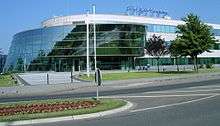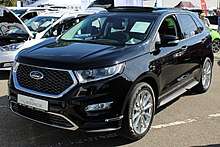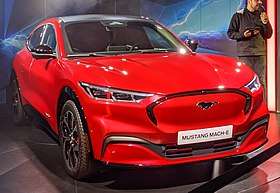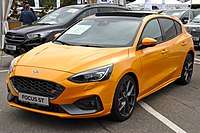Ford Germany
Ford-Werke GmbH[1] is a German car manufacturer headquartered in Niehl, Cologne, North Rhine-Westphalia and a subsidiary of Ford of Europe, which in turn is a subsidiary of Ford Motor Company. The company operates two large manufacturing facilities in Germany, a plant in Cologne and a plant in Saarlouis.
 | |
| GmbH | |
| Industry | Automotive |
| Founded | August 18, 1925 |
| Founder | Henry Ford |
| Headquarters | Niehl, Cologne, North Rhine-Westphalia , |
Number of locations | Two manufacturing facilities |
Key people | Gunnar Herrmann (Chairman) Wolfgang Kopplin (CEO) |
| Products | Automobiles |
| Owner | Ford Motor Company |
Number of employees | 28,842 (2009) |
| Parent | Ford Deutschland Holding GmbH |
| Website | ford |
Berlin origins
The earliest presence of the Ford Motor Company in Germany was a parts operation set up in Hamburg in 1912.[2]
At the end of 1924 the US Ford Motor Company established a sales office in Berlin which at the start of 1925 received a permit to import 1,000 tractors. In 1920 the government had imposed a tariff so high that it amounted to a prohibition against importing foreign automobiles, but this was reversed in October 1925. The move had evidently been anticipated by Ford, since on 18 August 1925 the Ford Motor Company Aktiengesellschaft had been entered in the Berlin Companies Register.[3]
During 1925 an assembly plant was constructed in a rented warehouse in the Westhafen (western port) district of Berlin, which was well located for receiving deliveries of kits and components via the country's canal network. On 1 April 1926 the first German assembled Model T was produced, using imported parts.[4] The Berlin assembly operation produced 1,177 Model Ts in 1926 and a further 2,594 during 1927 which was the Model T's final year: in August 1927 Model T production in Berlin ended, and it was nearly a year before, on 20 August 1928, Ford auto-production in Berlin recommenced, now of the Ford Model A.[3]
Relocation to Cologne

In March 1929 General Motors purchased a controlling 80% holding in Opel. Henry Ford's reaction was a prompt decision to build a complete Ford auto-factory in Germany, and before the end of 1929 a site at Cologne (Niehl) made available by the mayor of the city, Konrad Adenauer[4] was acquired by Ford.[5] The 170,000 m2 site was originally intended to support an annual production of 250,000 cars, suggesting a continuation of the spirit of boundless economic optimism that seized western industry in the months preceding the 1929 Wall Street crash. Locating the plant directly beside the Rhine ensured that, as with Ford's other principal European manufacturing locations in Manchester, Dagenham and Berlin, excellent access existed to the water transport network. On 2 October 1930 Henry Ford, then age 67, together with Adenauer, age 55, laid the foundation stone for the Cologne Ford Plant: construction, which cost 12 Million Marks, progressed rapidly. The assembly operation in Berlin came to an end on 15 April 1931, and on 4 May 1931 the first Cologne produced Ford rolled off the production line.[6] The first vehicle produced was a Ford Model A based truck which, whether by coincidence or by design would also be the first vehicle produced by Ford's new plant at Dagenham, England in October 1931. From that time an increasing proportion of the Ford vehicles sold in Germany were also made in Germany rather than being imported. The Model A was joined at Cologne in 1932 by the Model B.
Small car manufacture started in 1933 with the Ford Köln, a year after its British launch as the Model Y. With 2,453 produced in 1933 alone, the Köln propelled Ford to eighth place in the German passenger car sales charts for that year,[7] but it did not have the same impact in Germany as it did in Britain, and was undercut in price by the small Opel.[8]
The Ford Rheinland was a unique model for the German market made by fitting a four-cylinder 3285 cc engine into a Model B V-8 chassis but most products continued to be Detroit designs albeit with local names.
The Eifel was the German version of the 10 hp which was sold in Britain as the Model C. 61,495 Eifels were produced by Ford Germany between 1935 and 1940, which was well over half of all the German Ford produced in the period, enabling Ford's German sales to overtake those of Adler in 1938, making Ford Germany's fourth largest automaker, behind Opel, Mercedes-Benz and DKW.[7] The Eifel was joined in 1939 by the first of the long running Taunus range.
Ford-Werke AG later Ford-Werke GmbH

The company was re-organised in 1939 and changed its name to Ford-Werke.[4] With the outbreak of the War, car production continued at first with the Taunus being made until 1942 but increasingly military production took over. Ford-Werke built both conventional trucks and Maultier half-tracks for the German armed forces. Most notably, Ford-Werke manufactured the turbines used in the V-2 rockets.[9] In spite of the heavy bombing of Cologne, the factory got off relatively lightly and after the war production was able to restart in May 1945 with truck manufacture, the US government having paid $1.1 million in consideration of bombing damage.[4]
_at_Schaffen-Diest_(2017)_01.jpg)
Car making restarted in late 1948 with the Taunus. Henry Ford II visited the factory in 1948 during his visit to Germany when he was considering a purchase of Volkswagen, with which he did not ultimately proceed.[4]
In 1952 a new Taunus appeared and this had much in common with the British Ford products and was a great success enabling record production figures to be reached. The company was now being run by Ehrhart Vitger and he spent time recruiting new dealers to replace those lost in East Germany but the company continued to rank third in sales in Germany behind VW and Opel.[4]
Ford began to integrate the operations of its European subsidiaries in the 1960s with the launch of the 1965 Ford Transit panel van, which was a joint development between Ford of Britain and Ford-Werke, however it was the Ford Escort in 1968 that truly marked the end of unique models in European countries and followed the creation of Ford Europe in 1967 from the assets of the British and German operations but the corporate entities continue.
General Motors would later follow Ford's lead in the 1970s by integrating its Opel and Vauxhall subsidiaries into GM Europe.
Use of forced labor during World War II
During the Second World War, Ford Werke employed slave laborers although not required by the Nazi regime.[10] The deployment of slave labor began before the Ford-Werke was separated from the Ford Motor Company in Dearborn, Michigan, while America had not yet entered the War.
Robert Hans Schmidt presided over Ford-Werke during the Second World War, and engaged slave labor and the illegal manufacture of munitions, including such manufacturing during the period before the U.S. entry into the War. Once the War was over, "notwithstanding all his carefully publicized efforts to erase the stain of the company's past, no evidence emerged that either Henry Ford II or any other top-level Ford Motor Company executive ever raised any moral objects to rehiring [Schmidt], who had presided over one of the company's darkest chapters.[11]
In 1942, German soldiers swept into the city of Rostov in the Soviet Union, moving among the homes of Rostov families, forcing them to register at a labor registration center. Elsa Iwanowa, who was 16 years old at the time, and many other Russians were transported in cattle cars to Wuppertal in the western part of Germany, where they were exhibited to visiting businessmen. From there Elsa Iwanowa and others were forced to become slave laborers for Ford-Werke. "On March 4, 1998, fifty-three years after she was liberated from the German Ford plant, Elsa Iwanowa demanded justice, filing a class-action lawsuit in U.S. District Court against the Ford Motor Company."[12] In court, Ford acknowledged that Elsa Iwanowa and many others like her were "forced to endure a sad and terrible experience" at Ford-Werke; Ford, however, maintained that cases like that of Elsa Iwanowa are best redressed on "a nation-to-nation, government-to-government" basis.[9] In 1999, the court dismissed Elsa Iwanowa's suit; however, a number of German companies, including GM subsidiary Opel, agreed to contribute $5.1 billion to a fund that would compensate the surviving slave laborers.[9] After being the subject of much adverse publicity, Ford, in March 2000, reversed direction, and agreed to contribute $13 million to the compensation fund.
Ford Motor Co. AG
Until 27 January 1950 all Ford's European operations other than in the USSR were run from Dagenham and owned by Ford Motor Company Limited, Dearborn's 55% owned subsidiary. In Ford Motor Company Limited's published reports to their British shareholders Germany and the other Ford European interests were referred to as 'the associated companies'.[13] These associate companies had been established in order to allow for substantial holdings by local shareholders.[note 1] On the outbreak of the second world war those shares in Ford Motor Company AG not belonging to German shareholders were placed under the control of the German Commissioner for dealing with enemy property.
Aston Martin Engine Plant
In October 2004, when Aston Martin was a wholly owned subsidiary of Ford, the company set up a dedicated 12,500 square metres (135,000 sq ft) engine production plant within the Ford Niehl plant, with capacity to produce up to 5000 engines a year by 100 specially trained personnel. Like traditional Aston Martin engine production in Newport Pagnell, assembly of each unit is entrusted to a single technician from a pool of 30, with V8 and V12 variants assembled in under 20 hours. By bringing engine production back to within the company, the promise was that Aston Martin would be able to produce small runs of higher performance variants engines.[14]

Marketing
Sales and market share in Germany
| Year | Units | Market share |
|---|---|---|
| 2012 | 206.128 | 6,70% |
| 2011 | 230,939 | 7,31% |
| 2010 | 198,156 | 6,79% |
| 2009 | 290,620 | 7,63% |
| 2008 | 217,305 | 7,03% |
| 2007 | 213,873 | 6,79% |
| 2006 | 243,845 | 7,03% |
| 2005 | 246,814 | 7,38% |
| 2004 | 243,930 | 7,47% |
| 2003 | 235,279 | 7,27% |
Models
Current model range
The following tables list Ford production vehicles that are sold in Germany in 2020:
Passenger cars
| Ka+ | City car |
| |
| Fiesta | Supermini |
| |
| Ecosport | Mini crossover SUV |
| |
| Focus | Small family car |
| |
| Kuga | Compact crossover SUV |
| |
| Mondeo | Large family car |
| |
| S-Max | Large MPV |
| |
| Galaxy | Large MPV |
| |
| Edge |  |
Mid-size crossover SUV |
|
| Puma | crossover SUV |
| |
| Explorer | SUV |
| |
| Mustang Mach-E |  |
SUV |
|
| Mustang | Muscle Car |
| |
| GT | Sports Car |
|
Light commercial vehicles
| Tourneo Connect | Panel van |
| |
| Transit |  |
Light commercial vehicle |
|
| Ranger | Pick-up truck |
|
ST models
Ford produce high-performance derivatives of their cars developed by their Ford Team RS division.
| Ford Focus ST |  |
Compact car |
|
| Ford Fiesta ST | Supermini |
|
Former Ford Germany Models model range
This is a list of models produced by Ford Germany prior to the creation of Ford of Europe. Although the Taunus TC and MK3 Ford Cortina were related, the body work and engines were different.
Notes
-
The company (Ford Motor Company Limited of Dagenham) has been formed to acquire and carry on as a going concern the business of motor vehicle manufacturers of:
- Ford Motor Company (England) Limited, Manchester
- Henry Ford and Son Limited, Cork
It will also acquire through holding their share capitals:- Automobiles Ford S.A., Paris
- Ford Motor Company A/S, Copenhagen
- Ford Motor Company S.A.E., Barcelona
- Ford Motor Company of Belgium S.A., Antwerp
- Ford Motor Company d'Italia S.A., Trieste
- N.V. Ford Motor Company of Holland, Rotterdam
- Ford Motor Company A.B., Stockholm
- Ford Motor Company A.G., Berlin
- Ford Motor Company of Finland O/Y, Helsingfors
The new company will offer 40% of the share capital of all the Continental companies to the public in their respective countries.
The Company will also acquire the sole and exclusive rights . . . Ford products in the following parts of the world:- United Kingdom and Ireland the Channel Islands and the Isle of Man
- The continent of Europe (excluding USSR)
- Asia Minor, Iraq, Persia, Afghanistan, Egypt and certain other parts of Africa
and the benefit of all the patents inventions, drawings, designs . . . . . owned by the Ford Motor Company of America and Mr Henry Ford
See also
- Henry Ford
- Ford of Europe
- Ford Motor Company
- Ford of Britain
- List of German cars
- Merkur
References
- Oswald, Werner (2001). Deutsche Autos 1920-1945, Band (vol) 2 (in German). Motorbuch Verlag. ISBN 3-613-02170-6.
- "Datenschutz und rechtliche Hinweise". ford.de. Retrieved 10 April 2018.
- Wilkins, Mira; Hill, Frank Ernest (27 June 2011). "American Business Abroad: Ford on Six Continents". Cambridge University Press. Retrieved 10 April 2018 – via Google Books.
- Oswald, p 411
- Georgano, N. (2000). Beaulieu Encyclopedia of the Automobile. London. ISBN 1-57958-293-1.
- Oswald, p 412
- Oswald, p 413
- Oswald, pp 112 & 531
- Oswald, pp 112 & 314
- Wallace, Max. (2003). The American axis: Henry Ford, Charles Lindbergh, and the rise of the Third Reich. New York: St. Martin’s Press.
- Baldwin, Neil (2001). Henry Ford and the Jews: The Mass Production of Hate. New York: Public Affairs.
- Wallace, pp. 360-1
- Wallace, p. 333
- Ford Motor Company Ltd. The Times, Monday, April 17, 1950; pg. 9; Issue 51667; col E
- "Archived copy". Archived from the original on 2011-10-12. Retrieved 2011-12-03.CS1 maint: archived copy as title (link)
External links
| Wikimedia Commons has media related to Ford Deutschland. |
- Website (in German)
- Documents and clippings about Ford Germany in the 20th Century Press Archives of the ZBW
